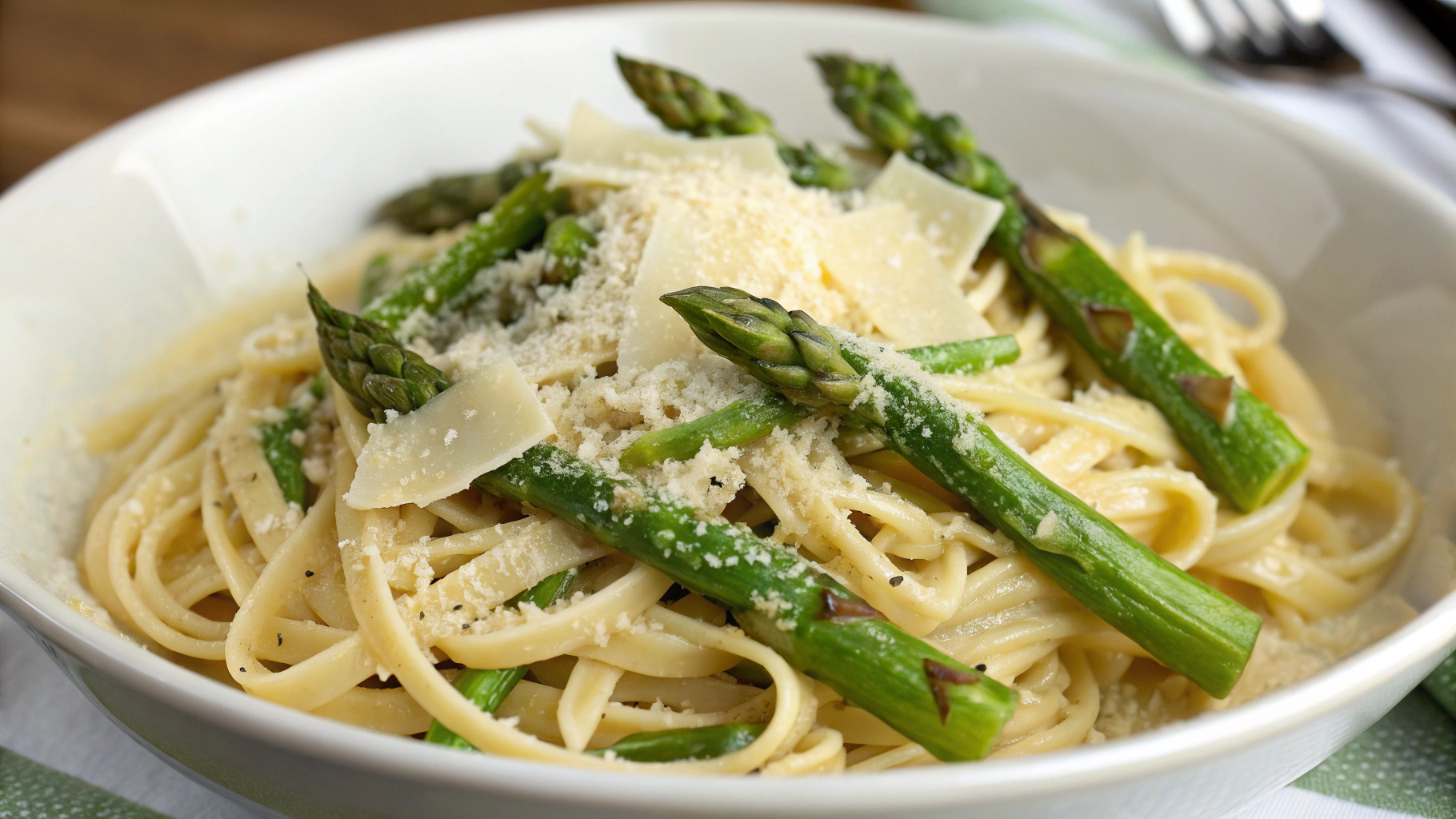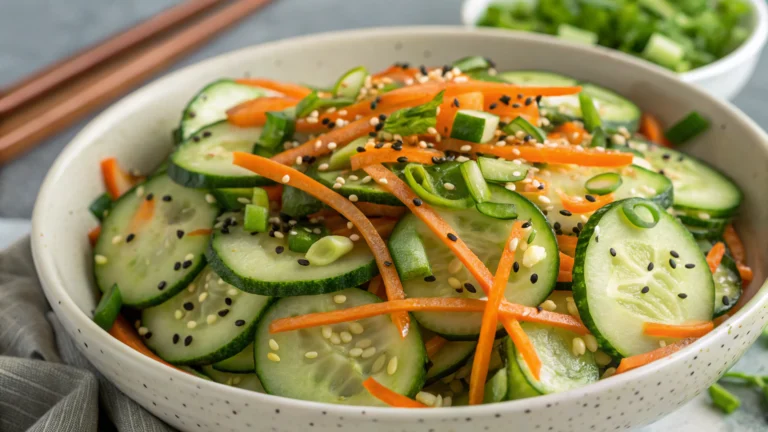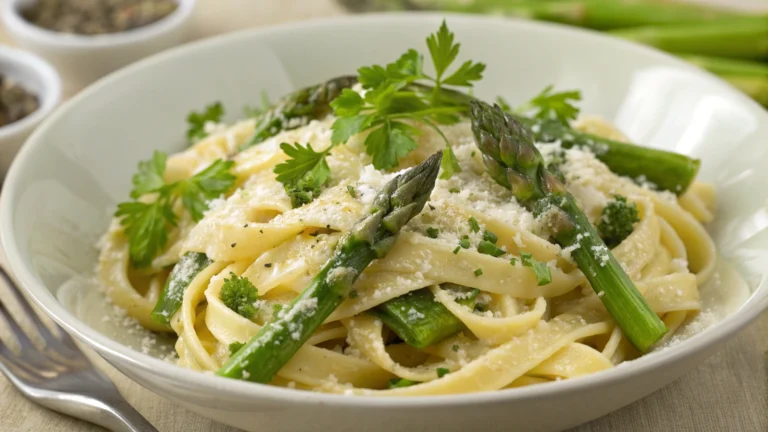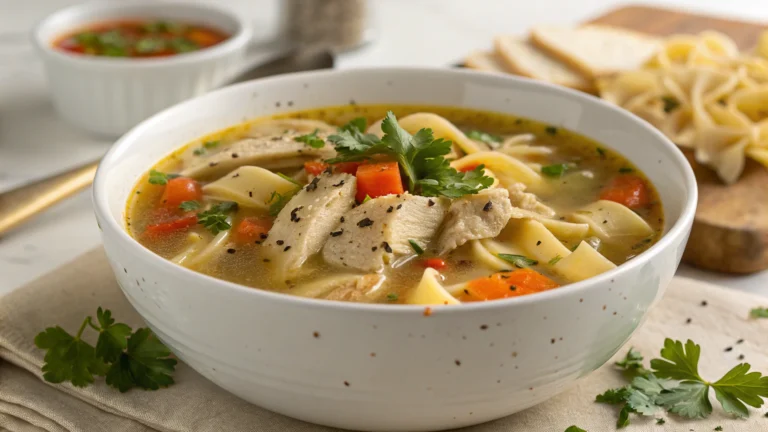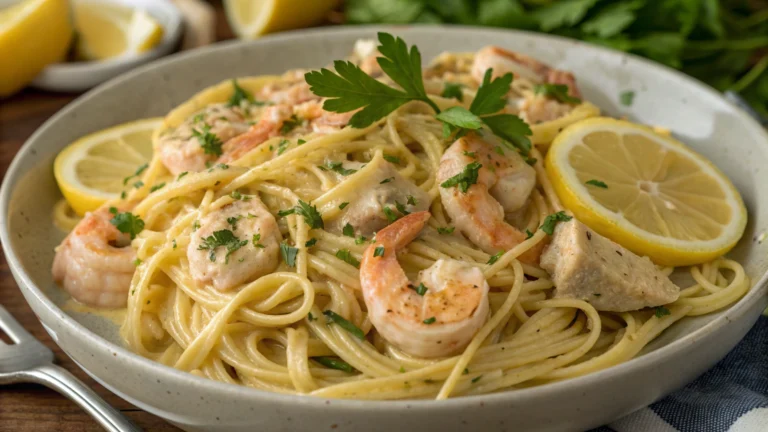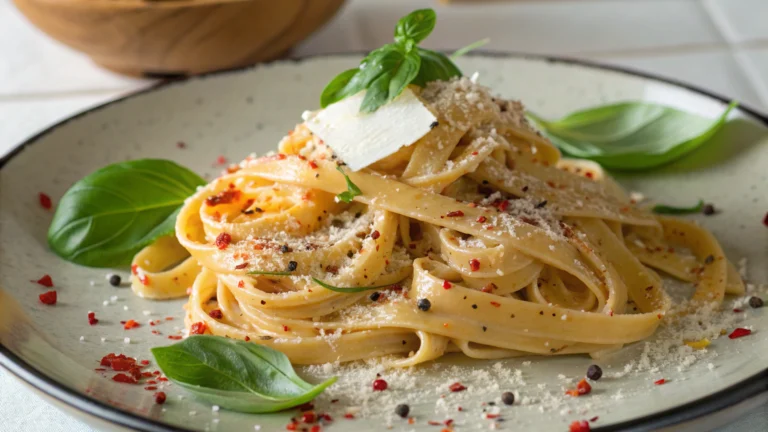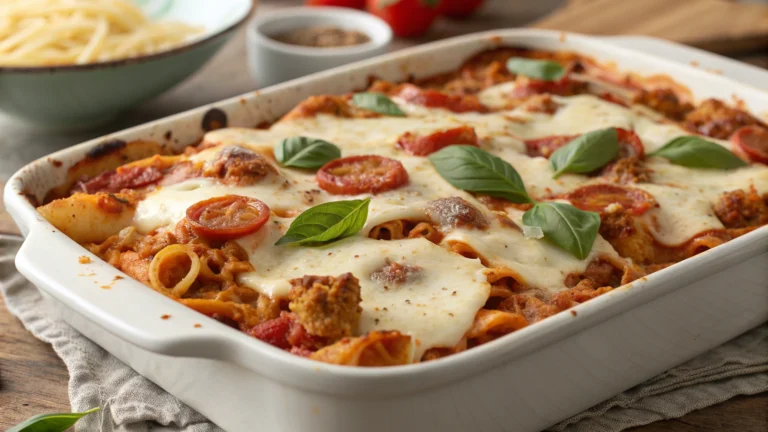Creamy Asparagus Pasta with Parmesan Recipe
Forget the steakhouse—this is the kind of silky, craveable comfort you can flex in 25 minutes with one pan and a pot. The sauce? Velvety, glossy, and clings to every noodle like it’s got rent due.
Asparagus brings snap and freshness, so you don’t feel like you just ate a brick. And the Parmesan? It melts into a savory blanket that makes you wonder why you ever ordered delivery.
If you can boil water and stir a spoon, you’re about to win dinner.
Why This Recipe Never Fails
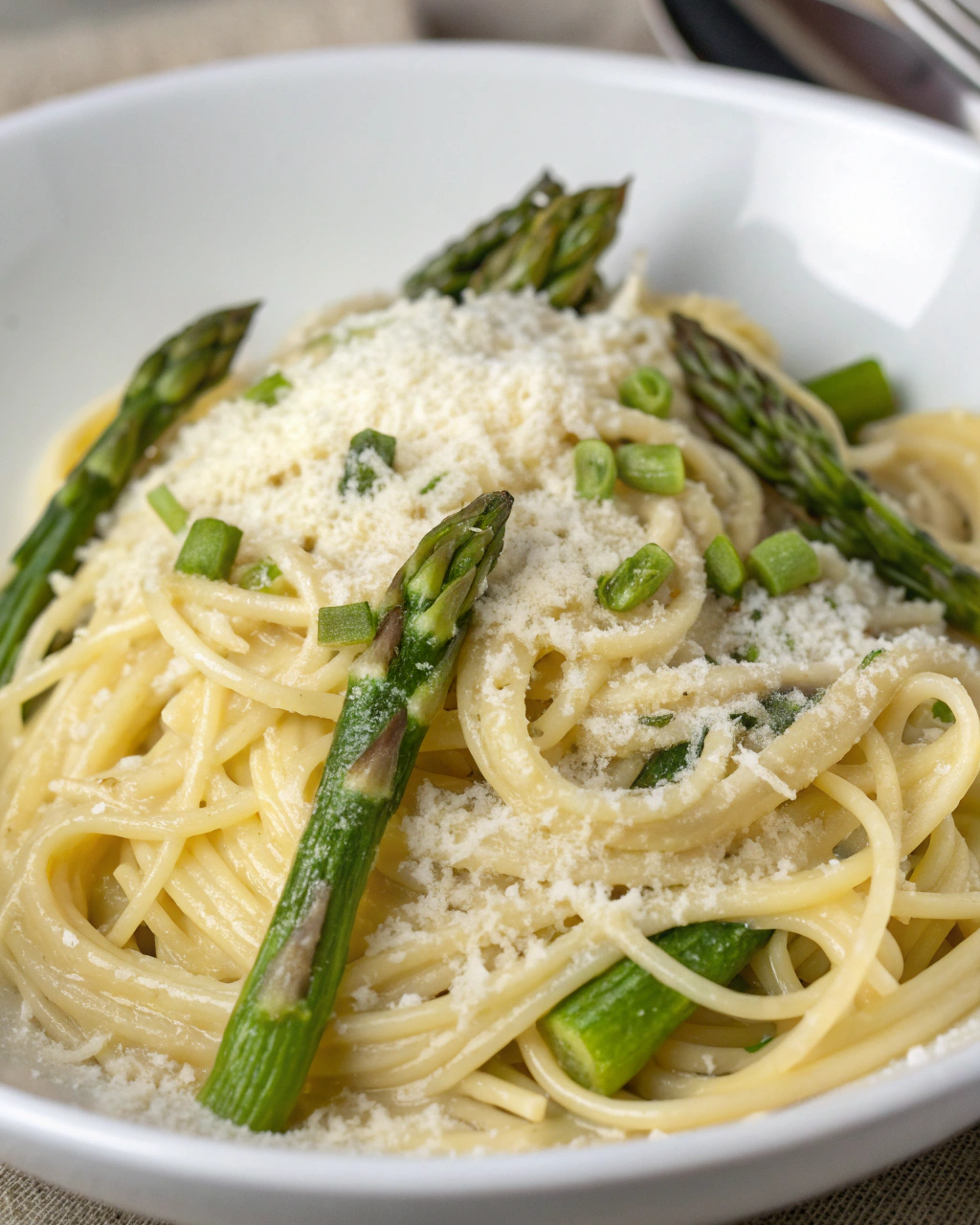
This dish nails the trifecta: speed, simplicity, and flavor that tastes expensive. The starch from the pasta locks the sauce, so it turns creamy without fuss. Asparagus cooks fast and stays bright—no sad, limp greens here.
Plus, Parmesan and lemon bring a one-two punch of umami and freshness that forgives minor mistakes. Even if you eyeball measurements (we see you), it still lands.
Servings, Prep time, Cooking time, Calories
- Servings: 4
- Prep Time: 10 minutes
- Cook Time: 15 minutes
- Total Time: 25 minutes
- Calories: ~560 per serving (estimate)
The Essentials You’ll Need
- 12 oz pasta (fettuccine, linguine, or short pasta like penne)
- 1 lb asparagus, trimmed and cut into 1–2-inch pieces
- 2 tbsp olive oil
- 2 tbsp unsalted butter
- 3 cloves garlic, thinly sliced or minced
- 1/2 tsp red pepper flakes (optional but recommended)
- 1 cup heavy cream (or 3/4 cup cream + 1/4 cup whole milk)
- 3/4–1 cup freshly grated Parmesan (plus more for serving)
- 1 tsp lemon zest + 1–2 tbsp lemon juice
- 1/2 cup reserved starchy pasta water (have up to 1 cup ready)
- Salt & black pepper, to taste
- Fresh parsley or chives, chopped, for garnish
- Optional: 1/4 cup dry white wine; 1/3 cup peas; 2 oz prosciutto or pancetta
How to Make It – Instructions
- Boil the pasta: In a large pot of well-salted water (it should taste like the sea), cook pasta to just shy of al dente. Scoop out at least 1 cup pasta water before draining.
- Blanch the asparagus: During the last 2 minutes of pasta cooking, toss the asparagus into the pot.
They’ll turn bright green and tender-crisp. Drain together and set aside.
- Sauté aromatics: In a wide skillet, heat olive oil and butter over medium. Add garlic and red pepper flakes, stirring for 30–45 seconds until fragrant.
Don’t brown the garlic unless you enjoy bitterness (you don’t).
- Optional deglaze: Add white wine and simmer 60 seconds to reduce slightly. This adds acidity and depth—your future self will say thanks.
- Create the cream base: Pour in the cream and bring to a gentle simmer. Season with a big pinch of salt and a few grinds of pepper.
Simmer 2–3 minutes to thicken slightly.
- Emulsify: Add 1/4 cup pasta water to the cream and whisk. This starch anchors the sauce so it’s glossy instead of greasy.
- Add cheese off heat: Reduce heat to low. Sprinkle in Parmesan gradually, whisking until smooth.
If it gets too thick, loosen with more pasta water in small splashes.
- Combine: Add pasta and asparagus to the skillet. Toss to coat, adding splashes of pasta water until every strand is luxuriously coated.
- Brighten: Stir in lemon zest and juice. Taste and adjust salt, pepper, and heat (more red pepper flakes if you like a little drama).
- Finish and serve: Plate with extra Parmesan and herbs.
A drizzle of good olive oil on top is not required—but it is elite.
How Long Does It Keep?
Leftovers keep 3–4 days in an airtight container in the fridge. Reheat gently with a splash of water, milk, or cream over low heat until saucy again. The sauce tightens as it cools—totally normal.
Freezing? Not ideal; cream sauces can separate and turn grainy. Eat fresh if you can (IMO, best within 24 hours).
Why This is Good for You
Asparagus brings fiber, folate, and vitamin K, supporting digestion and bone health.
Lemon adds vitamin C and brightness, so the dish feels lighter than it looks. Parmesan packs protein and calcium with huge flavor, meaning you can use less and still get big payoff. Balanced carbs + fats + protein mean steady energy, not a food coma.
It’s comfort food with a conscience—yes, that’s a thing.
Nutrition Stats
- Calories: ~560 per serving
- Protein: ~21 g
- Carbs: ~62 g
- Fat: ~24 g (of which saturated ~13 g)
- Fiber: ~5 g
- Sodium: ~520 mg (varies with salt and cheese)
Numbers are estimates based on standard ingredients and 12 oz pasta. Adjust with whole-wheat pasta, lighter cream, or more veggies if you want to tweak macros.
Easy-to-Miss Errors
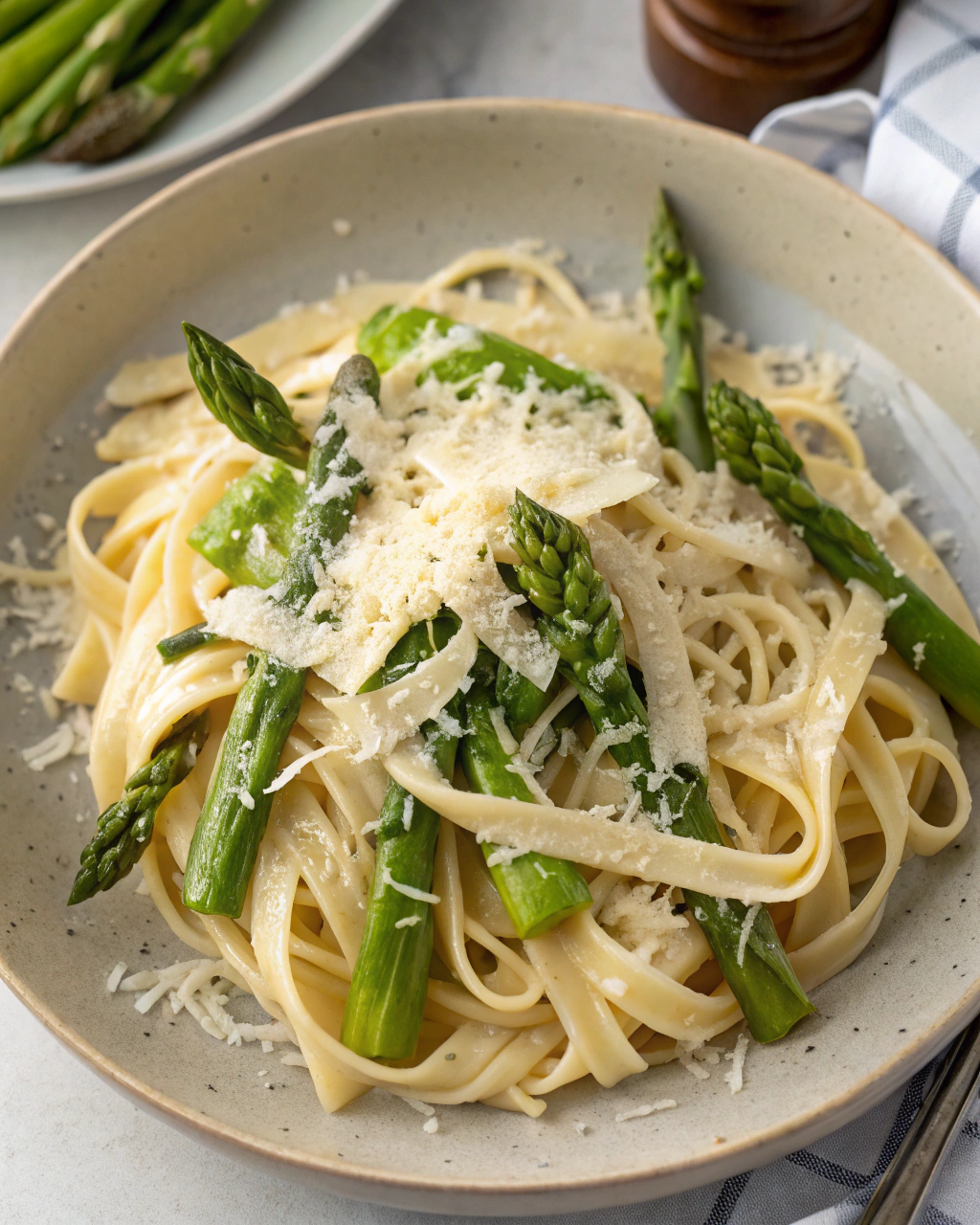
- Overcooking the asparagus: It should be bright green with a snap. Mushy asparagus is a vibe killer.
- Boiling the cream too hard: Gentle simmer only.
A rolling boil can break the sauce and make it oily.
- Adding Parmesan over high heat: Cheese can clump. Lower the heat and add gradually.
- Skipping pasta water: That starch is your sauce insurance. Keep it handy and use it.
- Undersalting the pasta water: The sauce can’t fix bland noodles.
Season the pot generously from the start.
- Using pre-grated cheese: It often contains anti-caking agents. Freshly grated melts smoother. Worth it.
Creative Twists
- Lemon-pepper bomb: Add extra zest and cracked black pepper for cacio e pepe energy.
- Spring medley: Toss in peas, baby spinach, or arugula at the end for color and bite.
- Protein upgrade: Fold in sautéed shrimp, grilled chicken, or crispy pancetta.
Prosciutto ribbons? Chef’s kiss.
- Herb-forward: Swap parsley for tarragon or basil to change the flavor profile dramatically.
- Lighter creaminess: Use half-and-half and finish with a knob of mascarpone for silk without heaviness.
- Nutty finish: Toasted pine nuts or almonds add crunch and contrast.
FAQ
Can I make this without heavy cream?
Yes. Use half-and-half and add 2 tablespoons mascarpone or a small knob of butter at the end for richness.
Keep heat low so it doesn’t split.
What pasta shape works best?
Long shapes like fettuccine or linguine are classic, but short cuts like penne or rigatoni catch the sauce in their ridges. Use what you’ve got—no wrong moves here.
How do I keep the sauce from getting grainy?
Add Parmesan off heat and in small handfuls, whisking each time. Use freshly grated cheese and keep the sauce at a gentle simmer, not a boil.
Can I make it gluten-free?
Absolutely.
Use your favorite gluten-free pasta and monitor cook time closely—GF pasta goes from al dente to overdone fast. Save that pasta water; it still works.
Is there a non-dairy option?
Use a rich, unsweetened plant cream (like cashew or oat) and a good vegan Parmesan-style cheese. Add 1–2 teaspoons nutritional yeast for deeper savoriness.
Do I have to use lemon?
Technically no, but you’ll miss the brightness that balances the cream.
Even a small squeeze wakes up the whole dish, FYI.
Chef’s Notes
– For next-level flavor, brown the butter slightly before adding the garlic—nutty aromas, zero extra effort. – Slice thicker asparagus on a bias for faster, even cooking and prettier presentation. – If you’re serving guests, hold back a little sauce, then finish each plate with a spoonful for that glossy, restaurant look. – Warm bowls make a difference; hot pasta + cold plates = fast-coagulating sauce. Run bowls under hot water first. – Keep it flexible. Taste as you go, adjust salt and acid, and remember: pasta water is your magic wand.

